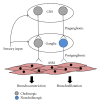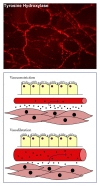Neuronal modulation of airway and vascular tone and their influence on nonspecific airways responsiveness in asthma
- PMID: 23150736
- PMCID: PMC3485909
- DOI: 10.1155/2012/108149
Neuronal modulation of airway and vascular tone and their influence on nonspecific airways responsiveness in asthma
Abstract
The autonomic nervous system provides both cholinergic and noncholinergic neural inputs to end organs within the airways, which includes the airway and vascular smooth muscle. Heightened responsiveness of the airways to bronchoconstrictive agents is a hallmark feature of reactive airways diseases. The mechanisms underpinning airways hyperreactivity still largely remain unresolved. In this paper we summarize the substantial body of evidence that implicates dysfunction of the autonomic nerves that innervate smooth muscle in the airways and associated vasculature as a prominent cause of airways hyperresponsiveness in asthma.
Figures


Similar articles
-
Autonomic innervation of human airways: structure, function, and pathophysiology in asthma.Neuroimmunomodulation. 1999 May-Jun;6(3):145-59. doi: 10.1159/000026376. Neuroimmunomodulation. 1999. PMID: 10213912 Review.
-
Cholinergic and neurogenic mechanisms in obstructive airways disease.Am J Med. 1986 Nov 14;81(5A):93-102. doi: 10.1016/0002-9343(86)90470-5. Am J Med. 1986. PMID: 2878614 Review.
-
[Airway autonomic nervous system dysfunction and asthma].Nihon Yakurigaku Zasshi. 1998 Apr;111(4):195-203. Nihon Yakurigaku Zasshi. 1998. PMID: 9618704 Review. Japanese.
-
[Airway autonomic nervous system dysfunction and asthma].Nihon Kokyuki Gakkai Zasshi. 1999 Jan;37(1):3-9. Nihon Kokyuki Gakkai Zasshi. 1999. PMID: 10087868 Review. Japanese.
-
Neural control of human airways in health and disease.Am Rev Respir Dis. 1986 Dec;134(6):1289-314. doi: 10.1164/arrd.1986.134.5.1289. Am Rev Respir Dis. 1986. PMID: 3538958 Review.
Cited by
-
The gain of smooth muscle's contractile capacity induced by tone on in vivo airway responsiveness in mice.J Appl Physiol (1985). 2015 Mar 15;118(6):692-8. doi: 10.1152/japplphysiol.00645.2014. Epub 2015 Jan 8. J Appl Physiol (1985). 2015. PMID: 25571989 Free PMC article.
-
School environment associates with lung function and autonomic nervous system activity in children: a cross-sectional study.Sci Rep. 2019 Oct 22;9(1):15156. doi: 10.1038/s41598-019-51659-y. Sci Rep. 2019. PMID: 31641175 Free PMC article.
-
Dexmedetomidine's inhibitory effects on acetylcholine release from cholinergic nerves in guinea pig trachea: a mechanism that accounts for its clinical benefit during airway irritation.BMC Anesthesiol. 2017 Mar 29;17(1):52. doi: 10.1186/s12871-017-0345-z. BMC Anesthesiol. 2017. PMID: 28356076 Free PMC article.
-
Genetics and Genomics of Longitudinal Lung Function Patterns in Individuals with Asthma.Am J Respir Crit Care Med. 2016 Dec 15;194(12):1465-1474. doi: 10.1164/rccm.201602-0250OC. Am J Respir Crit Care Med. 2016. PMID: 27367781 Free PMC article.
-
Increased Heart Rate Variability Response Among Infants with Reported Rhinorrhea and Watery Eyes: A Pilot Study.J Asthma Allergy. 2021 Nov 9;14:1349-1354. doi: 10.2147/JAA.S329347. eCollection 2021. J Asthma Allergy. 2021. PMID: 34785908 Free PMC article.
References
-
- National Heart, Lung and Blood Institute (NHLBI) Expert Panel Report 3. 07-4051. National Institutes of Health (NIH) Publication; 2007. Guidelines for the diagnosis and management of asthma.
-
- British Thoracic Society Scottish Intercollegiate Guidelines Network. British Guideline on the Management of Asthma. Thorax. 2008;63, supplement 4:iv1–iv121. - PubMed
-
- Smith LJ. Anticholinergics for patients with asthma? The New England Journal of Medicine. 2010;363(18):1764–1765. - PubMed
-
- Bousquet J, Jeffery PK, Busse WW, Johnson M, Vignola AM. Asthma: from bronchoconstriction to airways inflammation and remodeling. American Journal of Respiratory and Critical Care Medicine. 2000;161(5):1720–1745. - PubMed
LinkOut - more resources
Full Text Sources

